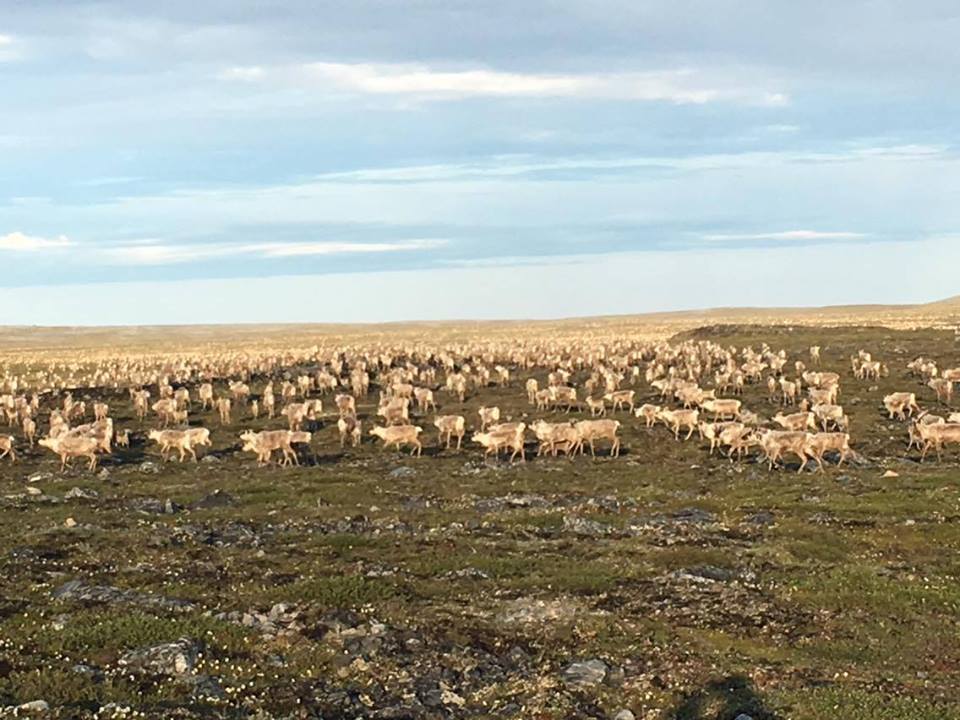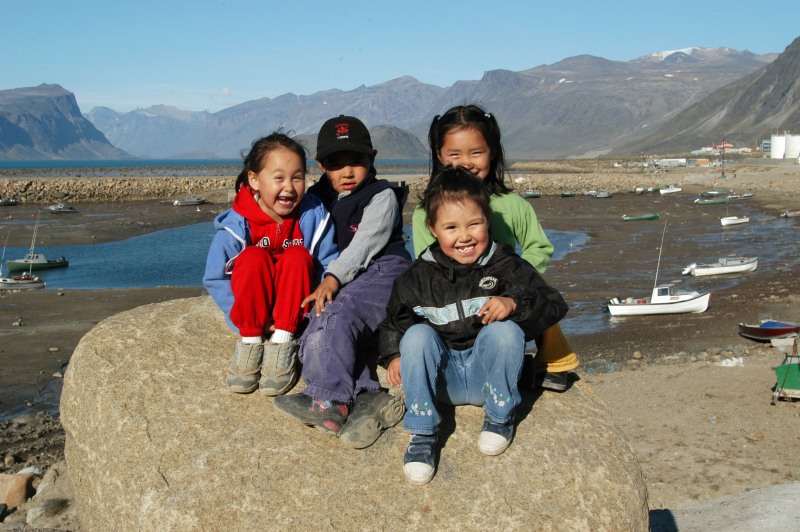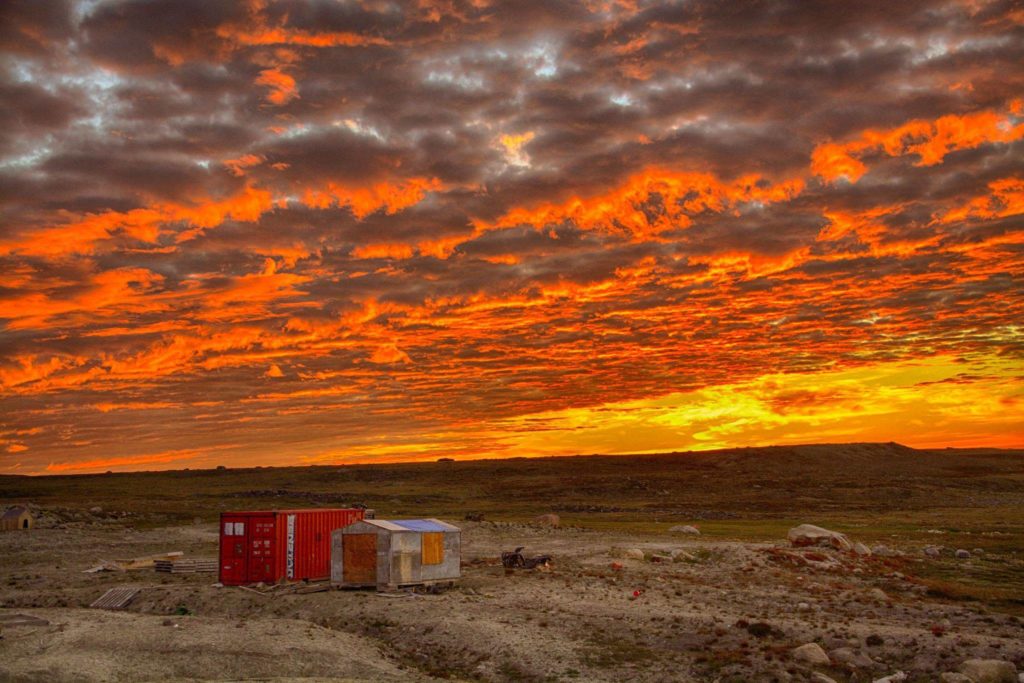by Steve Selden | Jul 11, 2017 | Churchill Photography
The Photo of the Week comes from Rankin Inlet, Nunavut taken by Dustin IInik. The magnificence of the northern caribou herd is striking when viewed across the wide open tundra of northern Canada. I personally, at some point, would like to try and film footage from within the migration itself by possibly rigging a fixed camera in a position where it wouldn’t get destroyed. Churchill summer and Arctic summer on the whole reveal incredible wildlife experiences that show themselves when you least expect them to. Enjoy!

by Steve Selden | May 9, 2017 | Churchill News

The Port of Churchill and Hudson Bay Railway are still up for sale by Omnitrax. Claude Daudet photo.
With negotiations between Omnitrax Canada and the Missinippi Rail Consortium, now down to just the Mathias First Nation, moving at the speed of a train on the last 100 miles to Churchill, another strong alliance has stepped up and expressed interest in acquiring the port and Hudson Bay Railway. Omnitrax does have a memorandum of understanding to negotiate the sale of its assets with MRC though the negotiations have recently stalled.
The new alliance called One North has apparently gathered widespread representation from various First Nations of northern Manitoba and incorporated municipalities residing up and down the rail line. The Kivaliq region in Nunavut has also reportedly joined forces with the group as well.
“This is an unprecedented coalition of communities — indigenous and non-indigenous. There is a historical significance here. Never in the history of northern Manitoba have all these communities come together like this in a shared vision.” stated Christian Sinclair, chief of Opaskwayak Cree Nation, and one of the key organizers of One North.
So far around 20 communities have joined forces with One North, including The Pas and the City of Thompson, two key, large communities on the rail line as well as all the First Nation communities served by the Hudson Bay Railway including Fox Lake, War Lake and York Factory. Many of these groups have rescinded their support letters from a year ago backing the Missinippi Rail Consortium run by Chief Arlen Dumas of Mathias Colomb First Nation and redirected them to One North Coalition.
The group has come together to not only purchase the assets of Omnitrax Canada and run the rail line and Port of Churchill but also facilitate a long term broader plan for the north and its people.
Churchill mayor Mike Spence has co-led the effort with Sinclair..
“We have a real issue here. We need to rectify it. We are putting together a model that will sustain these communities for a long, long time.” Spence said.
Omnitrax Canada place the port, rail line and assets up for sale in December 2015. Omnitrax president Merv Tweed at that time announced the company wanted to sell its Manitoba assets and was confident the company would have a deal in place before the end of 2015. That didn’t happen.
Dumas and Omnitrax entered into negotiations in January 2016 and although initial meetings seemed to imply a done deal, nothing has seemed to progress further.
When July came around, Omnitrax shocked the community of Churchill by laying off nearly 100 port workers and abruptly closed the doors to the port and cancelled the entire shipping season. No deal with with Dumas and his group was finalized.
Dumas and Omnitrax officials claim that talks are progressing well and that a deal is imminent though no recent news has surfaced on the deal. Omnitrax officials have not been available for comment on negotiations. When reached, Dumas had no awareness of One North’s interests. He did give away a little of his hand by stating; “Well, ask them to give me a call if they want to buy the assets and the interest off us.”
Sinclair admits One North is still trying to get an audience with Omnitrax. They currently have no official standing with the company and have only assembled a team with some technical expertise including Paul Power, an international railway specialist who was a founding director of the Keewatin Railway Company, and Marv Tiller, the original CEO of the North West Company who has had a long career assisting First Nations in successful economic development projects.
“We think Omnitrax does not want to talk to us because they want to get a management contract from the buyer, Missinippi Rail Consortium, so they can make $10 to $15 million advising and managing and have someone else take on the risk as well as cash out on all the government money that has been sunk into the line.” stated Power.
One North has made it clear to the government the direction they are wanting to go in and have met with Cliff Cullen, Manitoba’s minister of growth, enterprise and trade as well as Natural Resources Minister Jim Carr and the Manitoba caucus in Ottawa. Modest funding has been received from the $4.6-million Churchill and Region Economic Development Fund, established in September by the federal government though the group has been primarily self-funded to date.
“The federal government is fully aware of where we want to go,” Mayor Spence said. “They have indicated to us that they like the model, they like where we are going. It plays into what the government wants to do to develop a new strategic plan.”
by Steve Selden | Apr 24, 2017 | Churchill Photography
Some pretty incredible images from Nunavut and the far north. We love posting a glimpse of life in the Arctic since the colors and vastness of the landscape are truly unique and fascinating. The simplicity in life and the enduring landscape give one a sense of timelessness. Churchill summer adventures will soon provide a platform to see and interact with the natural treasures of the Arctic. Enjoy!

Northwest Territories’ Canol Trail. Jared David Sean Etchinelle photo.

Taloyoak, Nunavut! Life in the north in a mini amauti. Charlene Aningak Pauloosie photo.

Majestic northern sunrise.CBC photo.

Gorgeous day for a ski in Cape Dorset, Nunavut. Manny Noble photo.

Northern lights burst into the sky over Pangnirtung, Nunavut. Mike Helms photo.

Enjoying the beautiful day in Coral Harbour. Sabrina Nakoolak photo.
by Steve Selden | Feb 7, 2017 | Churchill News
In a time when the Canadian Arctic is the focus of energy and trade route exploration, there are human cultural issues that need to be part of the picture as well. Maatalii Okalik, is a young advocate for the ever expanding Inuit youth population and her passion is ensuring all young people of the north will be able to live to the same standards as other Canadians. The 27 – year old is president of Canada’s National Youth Council and her mantra is just that,;“to ensure that Inuit live the same quality of life as fellow Canadians.”

Maatalii Okalik Pres Natl Inuit Youth Council. Maatalii Okalik photo.
Okalik knows the road to Inuit health and education equality will be long and winding and will require hurdling deep – rooted social issues frozen in Canada’s colonial history. Okalik fervently believes that the federal government needs to be more active in revitalizing cultural practices, preserving and facilitating native languages, preventing suicides and upgrading and possibly subsidizing some infrastructure problems.
In Okalik, it appears the Inuit young population will have an inspired advocate for years to come. She was recently bestowed the honor of Indspire Laureate, given to Canadian indigenous professionals and young people demonstrating exceptional achievements in their chosen career. Additionally, Okalik was rewarded with the Qulliit Nunavut Status of Women Council’s Outstanding Young Woman Award!
Arctic Deeply, a northern publication recently interviewed Okalik and she conveyed some pretty informative and interesting thoughts on life in northern Inuit communities. Describing the most pressing concerns and issues of Inuit youth Okalik outlined a basic long – term action plan.
Foremost is the Inuit language -Inuktitut- not being allowed in residential schools. English has been forced upon students therefore degrading the native language of the Inuit people. Okalik contends that federal government in Ottawa should actively push to ensure that Inuit youth should be able to access crucial learning materials in their native language. This would set a basis for equitable education for all Canadians. When the Inuktitut language is watered down the culture will slowly be lost when exposed to the rest of the world.
Secondly, Inuit culture and customs have been identified as an identity crisis currently for Inuit youth. As the youngest, fastest growing population in Canada, Inuit youth are finding cultural practices hard to keep up with. School and work and raising young families impose time and cross – cultural constraints on the continuation of age – old Inuit culture. Youth programming has been seen and proposed as a solution. tradition and modernity need to be woven together more smoothly so to ease the differences between the two.

Inuit children in Pangirtung, Nunavut. Robert Galbraith photo.
The third, and most pressing issue, is suicide prevention in the north within the Inuit population. Inuit suicide rate ranks highest within Canada as well as internationally per capita. Okalik and her colleagues contributed to the national Inuit suicide prevention strategy identifying suicide historical tendencies and plans to control them in Inuit communities.
In all these issues it’s crucial to have Canadians as a whole understand the vast gap in social services whether it be housing, food insecurity, cultural access for youth, education or access to quality and equal health care. With Inuit communities existing on the lower end of the spectrum here, there needs to be help assimilating the people to a better way of life being exposed to them from outside. “To me it just doesn’t make sense for Inuit in our particular communities to be living in Third-World conditions. There should be a priority of Canada to address that inequity. It would be a proactive measure that would prevent some of the dire statistics, including our suicide rates.” states Okalik.
Okalik feels her dreams and definitive career moment will be when all Canadians, including Inuit, enjoy the same quality of life. “I think I’m happiest when I see understanding in someone’s eyes – whether that’s an Inuk youth who learned about the history of colonization, or a federal bureaucrat or high-level minister who decides that this should be a priority and it’s a basic human right.” Then that person might be motivated to try and solve the dilemma and possibly influence policy decisions that might impact Inuit in a favorable manner.
Okalik’s near – term hopes are for the federal government to follow through with the Truth and Reconciliation Commission’s call to action #66 restoring power to indigenous communities all across Canada including most urgently Inuit communities in the Arctic. “The other thing that I think that I’d like to see is the telecommunication of the Canadian Arctic to be at par with southern Canada, including internet and phone. We recognize that these are essential services. It’s not at par in the Arctic. That influences education. It’s really important. Especially when, across the Arctic, we don’t have hospitals in all of the communities. Telehealth for example, is something that’s being explored. We should have access all across the board. As well as internet.”
Lastly Okalik believes that air services across the Nunavut settlements need to become more essential since there are no roads to communities. Many of the social inequities pointed to here are critically impacted by this transportation mode.
by Steve Selden | Aug 23, 2016 | Churchill Photography
This incredible sunset in Clyde River, Nunavut is pretty amazing! It seems like the sunsets this summer have been some of the best we have ever seen…enjoy! Arctic northern adventures wouldn’t be the same without them.

Sunset in Clyde River, Nunavut. Nick Illauq photo.












